CLáUDIO GIL
PEOPLEText: Mariano Werneck
Cláudio Gil is an artist, teacher, designer and calligrapher based in Rio de Janeiro, Brazil. He is currently studying Design History at the Master’s course of the Rio de Janeiro State University. Since 2004, he travels around the country promoting calligraphy and exploring it’s contemporary possibilities through workshops for beginners, students and professionals from different areas.
Cláudio has participated in many exhibitions throughout Brazil. Always demonstrating some of the extended possibilities of calligraphy using unusual instruments such as needles and brooms and painting more than 100 meters of roll paper and 80 meters of fabric. He is the only brazilian artist who has participated in the 4 editions of the International Exhibition of Calligraphy in the cities of Saint Petersburg, Moscow and Velik Novgorod, Russia. Some of his masterpieces are part of the collection of the Contemporary Museum of Calligraphy in Russia.
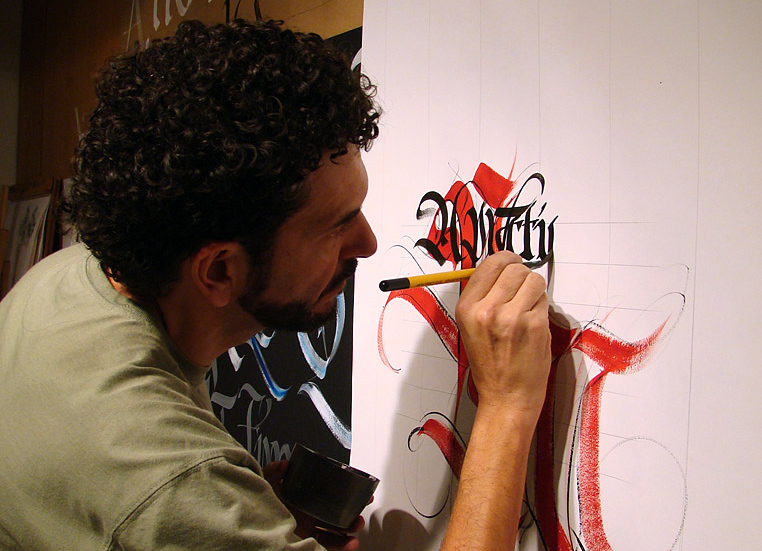
teaching at a workshop in São Paulo – 2012
Can you tell us a bit about your background?
I studied graphic design and got my diploma in 2004, but by the time I was graduating I had already been working for about 15 years. I have actually worked with graphic design for quite some time, from coordinating a team of 12 people publishing a magazine to having my own design studio for about 5 years. While in college, my first internship was at the university’s printer where I was not only able to get a deep understanding of the technical aspect of the printing process but also to work manually. At the time I was working with linotype setting, photo mechanics, film retouching and all that. This was of great value to me because even if we do everything digitally nowadays, when you go into production it’s all about matter, the physical substance. And it’s really important to know how to get the best of it. So, when I started working as a designer I had a strong knowledge about papers, ink, different printing processes and possibilities. I am now working on my Master’s degree and pushing myself out of my comfort zone to become a better writer, researcher, teacher and go on meeting new people and discovering new things.
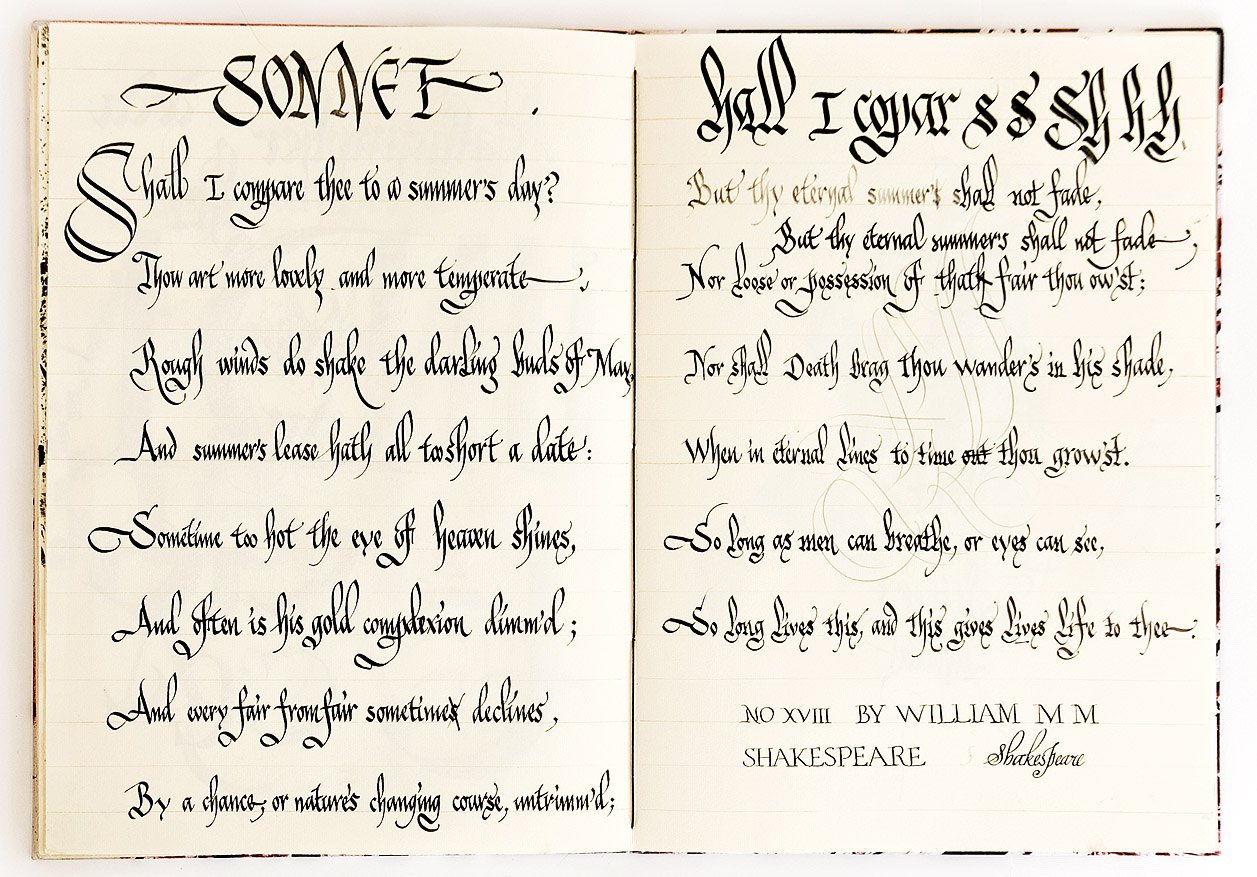
Practice for a Shakespeare’s Sonnet Piece, 2008, arts on handmade sketchbook by Gabriela Irigoyen, actually this sketchbook is temporary in Contemporary Museum of Calligraphy, Moscow, Russia.
Did your interest in calligraphy come from the work as a graphic designer?
I guess you could say that I’ve started really early with calligraphy. I have been drawing letters since I was 11 or 12 years old. It went on and off for some time but the choice to work professionally with manual arts came only in 2008, when I quit my day job. I had done an exhibition earlier that year here in Rio called Kalligrápho et non Kalligrápho and it was the time to practice and experiment on a daily basis. Training and drawing and learning more and more. I also started putting together workshops, organizing seminars and traveling around Brazil to promote my work. It all picked up from there.
But, you know, at first I was really more interested by the type designers. I knew very little about the calligraphers. In college I was really looking to develop my skills and went after more information on the subject, not only doing research but also looking for teachers. I met a lot of calligraphers but none of them were willing to teach. I just had to find good books and study hard, which at that time was not as easy as it is today. If you put “calligraphy” on youtube now, you’ll get tons of questionable tutorials, lessons and you can actually watch calligraphers at work. At the end i think this was a good thing because i learned to separate the good from the bad. It gave me a solid foundation and pointed me in the right direction. It was also interesting to see that the great type designers I admired were also very prolific calligraphers. You can see this very clearly if you look at the fonts Frutiger and Zapf were developing. They have very humanistic lines and forms.
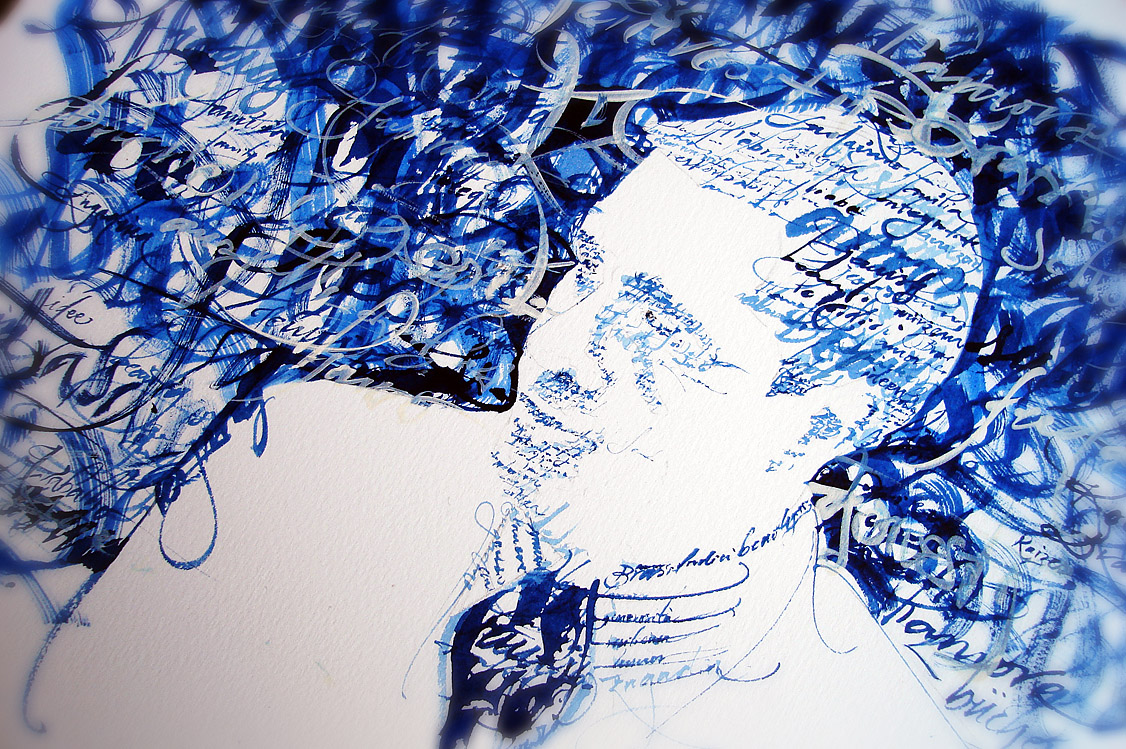
Commissioned caligram, watercolor and guache on paper, 33 x 31 cm, 2011
Do you have to be a perfectionist to work with calligraphy? How demanding are you about the proportions and forms when you work?
I would say yes. What’s important is to know the proportion to the letters. To observe the movement, the sequence of moves, the path drawn by the instrument you are using. Hermann Zapf used to say that he considers typography, letters on this case, as a two dimensional architecture. And I believe this pretty much covers it. You must observe these elements and repeat, and copy until your hand is well trained and able to reproduce the movement. You’ll get there by reading old books, studying calligraphy books and trying different styles. It’s really important to know the basis and have a strong knowledge of the craft to be able to break the rules afterwards.
When I started creating more abstract work i found a book by a french calligrapher called Claude Mediavilla. It’s fantastic what he does. He is a big time researcher and he goes into paleography which makes his work even more solid. To know the form of the letters is key. Our trace is unique. Each one of us will have our own. So you get to learn the forms, what is already there and has been with us for around 2000 years, a roman capital for example, to take that and make your own. Put your spin on it. The great scholars, just to mention Frutiger and Zapf again, are guys who have done extensive work over this subject matter, roman capitals, greek inscriptions, etc.
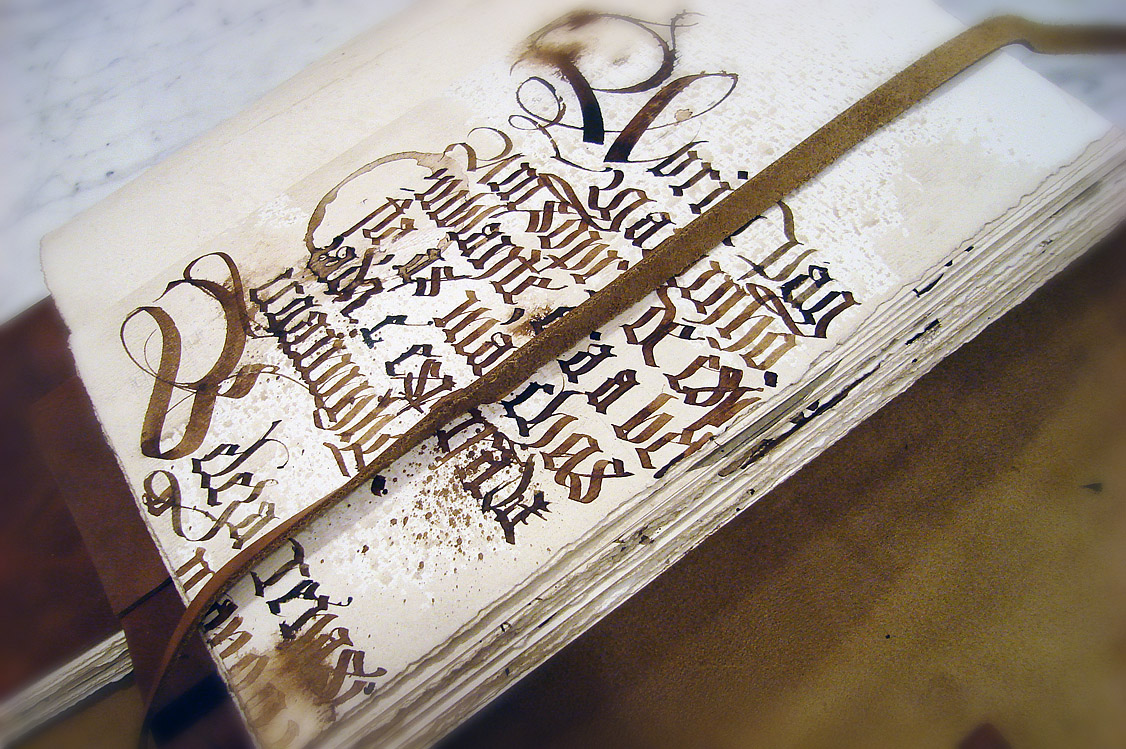
Calligraphy, commissioned work for Scenography, Theatre Play “Lição nº 18” de Doc Comparato, arts on handmade sketchbook by Gabriela Irigoyen, 2011
Do you find it hard to promote the kind of work you do in Brazil? Do you think it would be easier somewhere calligraphy played a more significant role?
I believe it would definitely have more exposure. In europe for example, history was built and written over it. Over here, Aldus Manutius was already producing type when Brazil was discovered. He was developing calligraphic models in cast metal, based on Gutemberg’s movable type. We don’t have a tradition. For us, I mean in portuguese, there is not even a distinction between calligraphy and writing. We are taught calligraphy at school, but it’s only for educational purposes, as in learning to write. There is no connection with an art form, technical aspects or different styles. It is not part of our culture as it is in arab countries or in China.

left: Silk screen poster, 50 x 70 cm, 2007, Collection piece of Contemporary Museum of Calligraphy, Moscow, Russia, right: Calligraphy, guache on paper, 50 x 70 cm, 2007, Collection piece of Contemporary Museum of Calligraphy, Moscow, Russia
And is this kind of artistic calligraphy an influence on you?
It is not something I study. But, i mean, it is a drawing. Every drawing, every style has it’s influence. There is not a lot of distinction to be made if you take, for example, a piece by Mediavilla, his abstract works, and put it next to something Hassan Massoudi, or Reza Abedini has done. Or even a John Stevens piece. It’s very much a reflexion of what comes from within. What these guys express, something more personal. All that you have within you will reflect in the way you draw, your trace, your line. Of course there are cultural differences and influences. There is also a matter of discipline, dedication. Some artists may find tools that they find more interesting. But it is something very organic, it changes depending on the context, depending on the moment. Today I believe we have open grounds to find our voice and be influenced by a multitude of things.
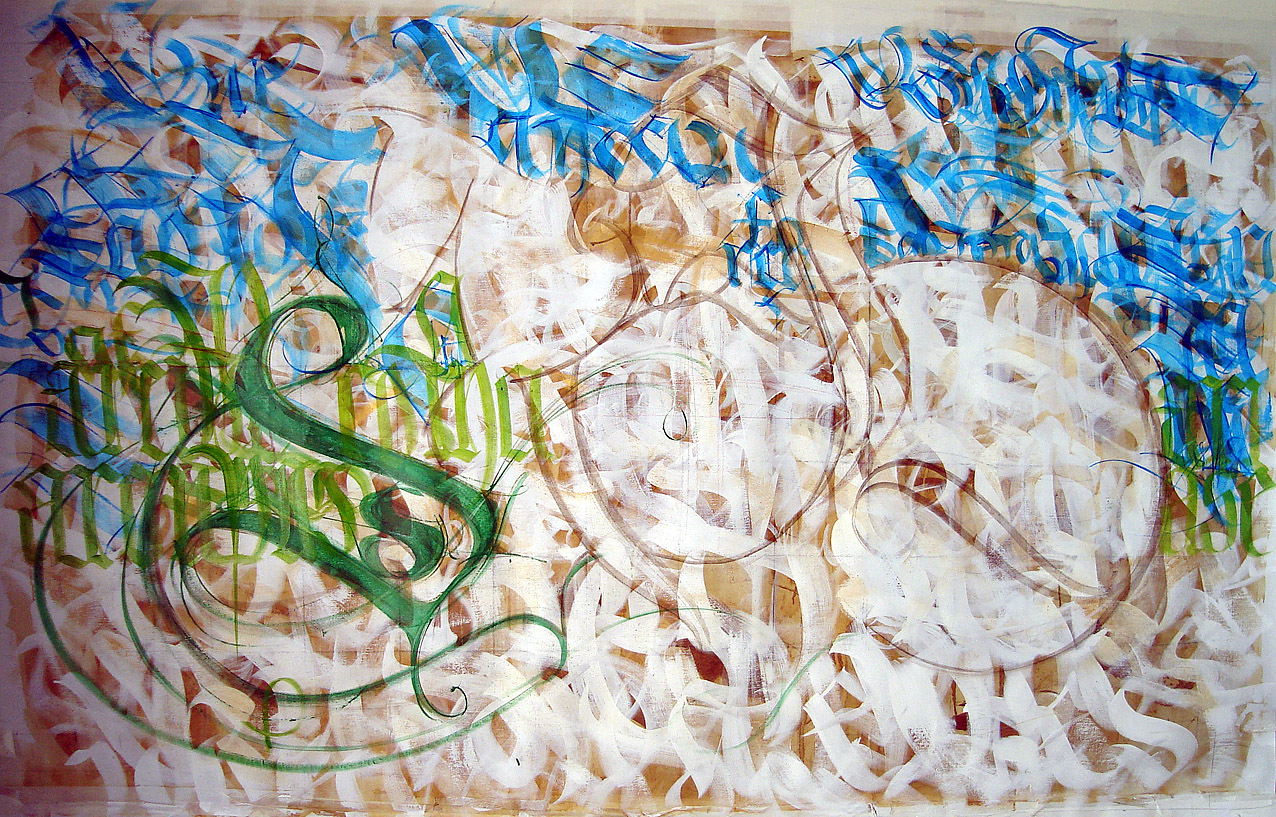
Development of a calligram, commissioned piece for Yara & Caíque Novis, Practice of Roman Capitals, acrylic on linen canvas, 220 x 145 cm, 2011
I feel like your work is a constant search for something new, unproven grounds. What’s your process like?
Well, i believe experimental is a good term for it. As I said, it is a matter of daily practice and discipline. I started calligraphy on my own, doing research, reading up and practicing a lot. It takes time to develop a muscle memory, to consolidate a motor skill to perform the precise movements. After that you can apply it through multiple tools. I’ve done calligraphy with brooms, needles, I’ve recently worked on a friend’s couch, painting it up for a reception. There’s a friend of mine in Italy called Massimo Polello, that does some amazing things with syringes. This is the beauty of it, we have endless possibilities. I just never stop going back to my sources, studying and learning again and again. Trying old forms again but with more confidence, a different understanding of it all. Maybe more mature. I truly think that this is what’s gonna take me a step further.
But, of course, there are different aspects depending on what I am doing. It’s one thing to be practicing, reproducing some pre-existing form to see how it works, how it’s made. To write a text is another. And to create an abstract calligraphy piece is a whole other thing. When I am doing commercial work, something like a monogram or a logo, i just start drawing and drawing and the letter will present me the solution. You don’t go for the solution straight away. I need to explore and find the answer within.
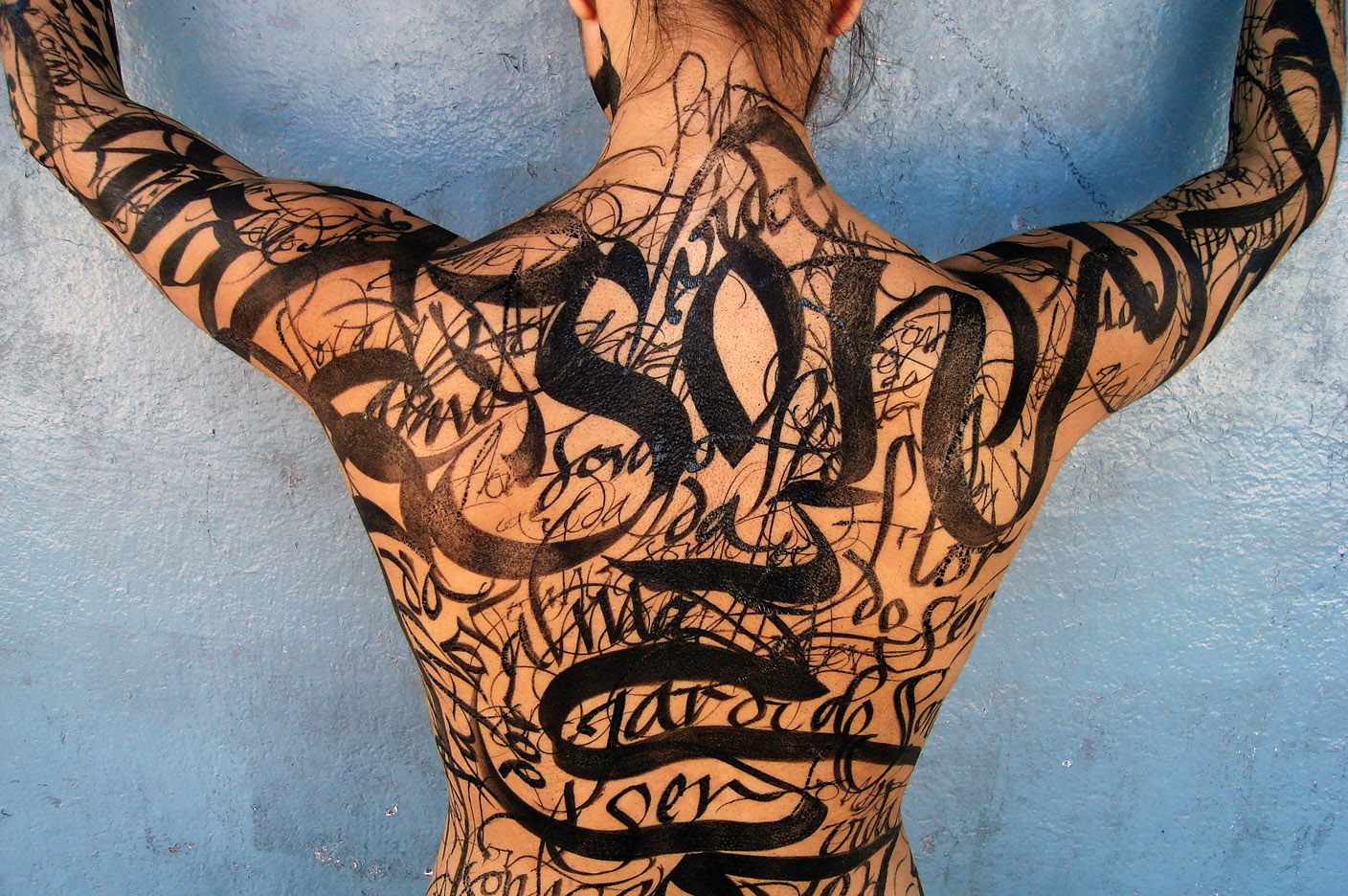
Body paint on the model Daniela Bado skin, Pablo Nora’s shortcut Quimera, 2008
How do you deal with the digital world today?
I come from a design background so the computer has always been there. I haven’t completely abandoned it yet, but today it is more of a finishing tool. In 2007 I made a commitment to myself to never use pre-existing fonts in the development of my commercial work. They now serve as starting points, but what I do is deliver my own style. My own spin. People complain that everything nowadays looks alike. Everything is done for the masses. But It is my belief that if someone came to me for a specific project, they want something of mine. That has my take on things, something exclusive. And this a great opportunity for me to take the time to consider his needs and, through a lot of drawings and experimentation, find my way of solving his problem. In the best way that I can. I guess, this process keeps me away from the computer. I mean, there are things that can’t be escaped. Last year I was working on a font for a wedding invitation, I developed all the character manually, retraced them all on the computer and gave it to a friend to turn into a proper font file with kerning adjustments, ligatures and all the mechanics. It’s a complicated process and feel like I should focus on what I am good at, which is drawing letters. There is another one coming any time soon and I hope to work in the same way. It’s great to be able to collaborate with people with other talents, it gives me great joy and allows a valuable exchange of ideas.
But in this case the computer must be a part of the process. Not to mention what the internet has brought us. You just can’t ignore it’s power. It became very simple to make your work, your sketches, available for the whole world to see. Most of the workshops I teach are promoted through the web, specially using social media. It’s an amazing tool.
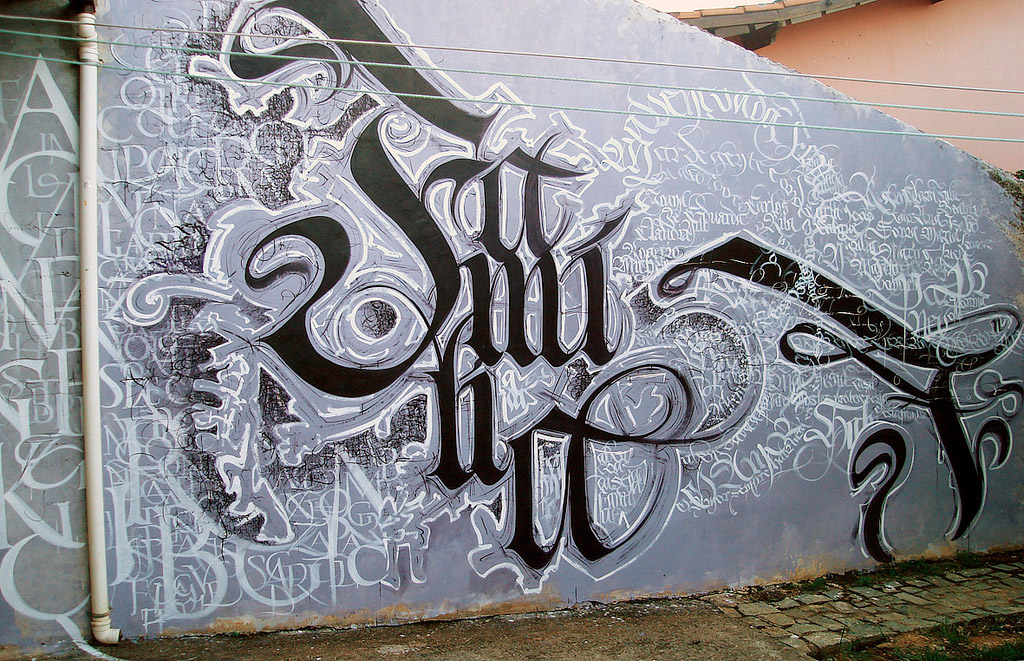
At Nésia Gil’s home, acrylic on concrete wall, 6 x 3m, Valença, Rio de Janeiro, 2012
What’s next?
My focus now is on finishing my master’s degree. Just do the best I can, develop my writing skills and keep working with other people. This has been wonderful. In the other hand I can’t just leave my art behind. It’s a very important part of me. I am also planning an exhibition for 2013. I haven’t done one in the last 2 years, even though I’ve been producing new material and working hard. So, the project is ready, I just need to iron out a few details and set it up. Other than that is just keep drawing, teaching and exchanging a lot with my students. Learning the most that i can from them. I am also trying to be healthier and take better care of myself. Sometimes during workshops i spend more than 10 hours standing with my arms up drawing on the board. It’s when you start to realize that you need good legs and posture to keep it up. It already gives me so much pleasure to do what I’ve been doing that now, with a few adjustments, 2013 is gonna be an amazing year.
Text: Mariano Werneck





